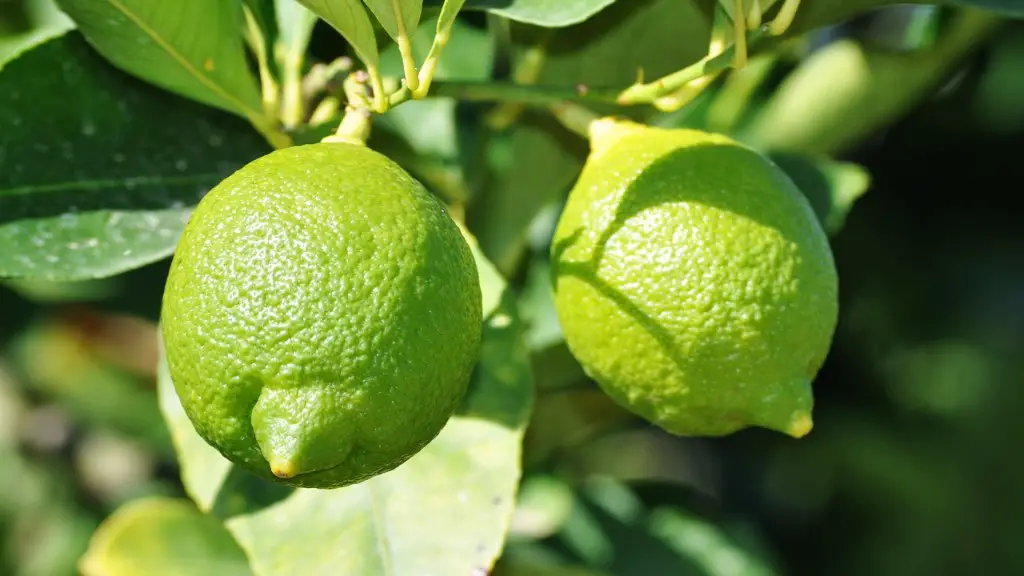2. Position the pot in a spot that receives plenty of sunlight throughout the day, preferably over 6 to 8 hours of direct exposure. Dwarf trees don’t require too much pruning, but they should be monitored periodically to check for any unwanted suckers and to trim branches that interfere with normal growth. A vigorous once a month pruning is recommended to maintain a nice shape.
3. To keep your tree well hydrated, water it frequently with a drip system. The soil must be moist to a depth of 8 inches throughout the growing season. If it gets too dry, the root system will suffer, so pay close attention to the moisture levels. Do not leave the soil soggy, as this can lead to root rot.
4. After the tree has been in the pot for a few months, apply a balanced fertilizer to enhance its growth and give it a healthy appearance. There are specialized lime or lemon tree fertilizers available in nurseries and garden centers. It is best to use a fertilizer that does not contain excessive levels of nitrogen or potassium, as these can inhibit the tree’s fruit production.
5. You can protect the tree and prevent disease by spraying it with a fungicide solution every few months. Doing this on a sunny day, away from any wind, is best. The frequency of the sprays depend on your location and the weather conditions. Your local gardening center can advise you on what product would be suitable for your needs.
6. Keep an eye out for pests that can cause damage to the tree. Common issues are aphids and spider mites, which can be easily taken care of with organic methods such as soap sprays and neem oil. Also, check for any signs of caterpillars or worms in the leaves, they can stunt the tree’s growth if they are left untreated.
7. When your tree is established and has grown to a substantial size it may be a good idea to repot it every 3 to 5 years in order to ensure its optimal health, as the tree’s root system will expand with growth. A pot with larger drainage holes is suitable for this purpose, as long as the tree is given enough fertilizers and sunlight for an abundant harvest of delicious lemons.
Fertilizer
1. Fertilizing a dwarf lemon tree is an important step for promoting vigorous growth and fruiting. Use only specially formulated materials for citrus trees as regular fertilizer can do more harm than good. Look for a fertilizer that is applied at the root system and contains nitrogen, calcium, magnesium and phosphorus.
2. The recommendation is to fertilize three times per year, in early spring, summer and early fall. Apply the fertilizer at the base of the tree, ensuring that it is not allowed to remain in contact with the stem. Fertilizer can burn the stem and bark and stunt root growth.
3. Regular check-ups should be made on your tree to determine if extra nutrients are needed. If the leaves are a pale green in colour and the growth is slow, an extra dose of fertilizer might be beneficial. Ensure the tree is always well-watered before application to minimize any burning.
Pruning
1. Pruning is a crucial task in keeping a dwarf lemon tree healthy and balanced. Pruning should be done on a regular basis to help with the desired shape of the tree and for eliminating dead, diseased or unproductive branches.
2. Prune the tree at least once a year in early spring. During this time look for branches that are too close or tangled with other nearby branches. You may also want to prune branches that grow too low or too high, or that cross over each other. This will help to promote overall air circulation and growth.
3. The tools you need for pruning are a pair of good quality handheld pruning shears and a pruning saw. Always ensure that the pruning shears are sharp, as using dull blades will cause unnecessary damage to the plant’s foliage and twigs.
4. Some branches may need to be removed that are too thick for the shears, so a pruning saw can be used. The saw blade should be slowly and gently guided through the wood without nudging or sawing back and forth.
Harvesting
1. The best time to start harvesting lemons from your dwarf tree is when the lemons begin to turn yellow and are about full size. Harvest them by cutting off the stem with pruning shears. Meticulously examine each lemon for signs of disease or damage before picking it.
2. To prolong shelf life, store the lemons in the fridge straight away. The lemons should be eaten within a week of harvest. If they are not needed immediately, they can be sliced and frozen. They can also be made into juice, lemonade or preserves.
3. It is important to note that some dwarf trees are unlikely to produce more fruit than you can eat or preserve. For those with more plentiful harvests, it is possible to make money off of them. Gather the lemons and place them in gift baskets or sell them at farmers markets.
Winter Care
1. During Winter, the dwarf lemon tree requires special care to keep it healthy and thriving. It is critical that you provide the tree with adequate protection from frost or snow. You can wrap the tree with a frost blanket or burlap if the temperature drops below 32 degrees Fahrenheit for extended periods of time.
2. If the tree does not have protection from the cold, it may be sensible to move the pot to a warmer and more sheltered spot. When moving the pot, cover the roots with soil to prevent injury to the root system.
3. The lemon tree also needs to be protected from drought in the winter. The soil should not be allowed to become completely dry and should be checked regularly to make sure it’s moist to a depth of 8 inches.
Pest and Disease
1. Dwarf lemon trees, like other citrus fruits, can suffer from various pest infestation and disease. Common pests are aphids, mites, caterpillars and scale insects, while some of the common diseases are citrus canker, dieback and lemon yellow leaf.
2. To prevent or eradicate pests, spray your tree with organic pest control products like soap sprays or neem oil. Spot treat the areas of pest infestations to avoid contamination of the entire tree. Monitor the tree for signs of disease and remove any diseased branches or leaves with pruning shears.
3. To avoid future infestations, it is beneficial to use natural methods to attract beneficial insects, like ladybugs and predatory mites which will help to keep pests in check. Providing your dwarf lemon tree with plenty of natural sunlight, adequate nutrition and protective pruning can help to keep it healthy and thriving.
Watering
1. Since watering is an essential part of keeping your tree healthy, it is important to ensure that it is done properly. Watering should be done daily in either the morning or the evening to ensure that the soil remains moist but never soggy. If you prefer, you can install a drip system to water the tree.
2. The amount of water should be sufficient to maintain the moisture levels on the soil, completing two wet and dry cycles during the summer months. During the winter months, the water requirement should be decreased as the tree’s growth slows down.
3. Always check the moisture level of the soil before watering. A good technique to use for this is to insert a long-handled spoon or similar object 8-10 inches down into the soil. If it comes out with moisture, the tree does not need to be watered.
Repotting
1. Repotting is a vital step in maintaining the health of a potted dwarf lemon tree. As the tree grows and its root system expands, it will require a new container with bigger drainage holes and fresh soil. A lightweight potting mix should be used as soil, as they are more water absorbent and provide better drainage.
2. It is recommended to repot the tree every three to five years in early spring. To remove the tree from its old pot, tilt the container and gently push it out, taking care not to damage any of the root system. Then, add fresh potting mix, place the tree into the pot and cover with soil.
3. To ensure the tree’s health and optimal air circulation, repotting should be done cautiously, taking care not to plug the drainage holes. Once the tree is secured in the pot and soil has been added around it, gently pat the soil and water with a generous amount.

